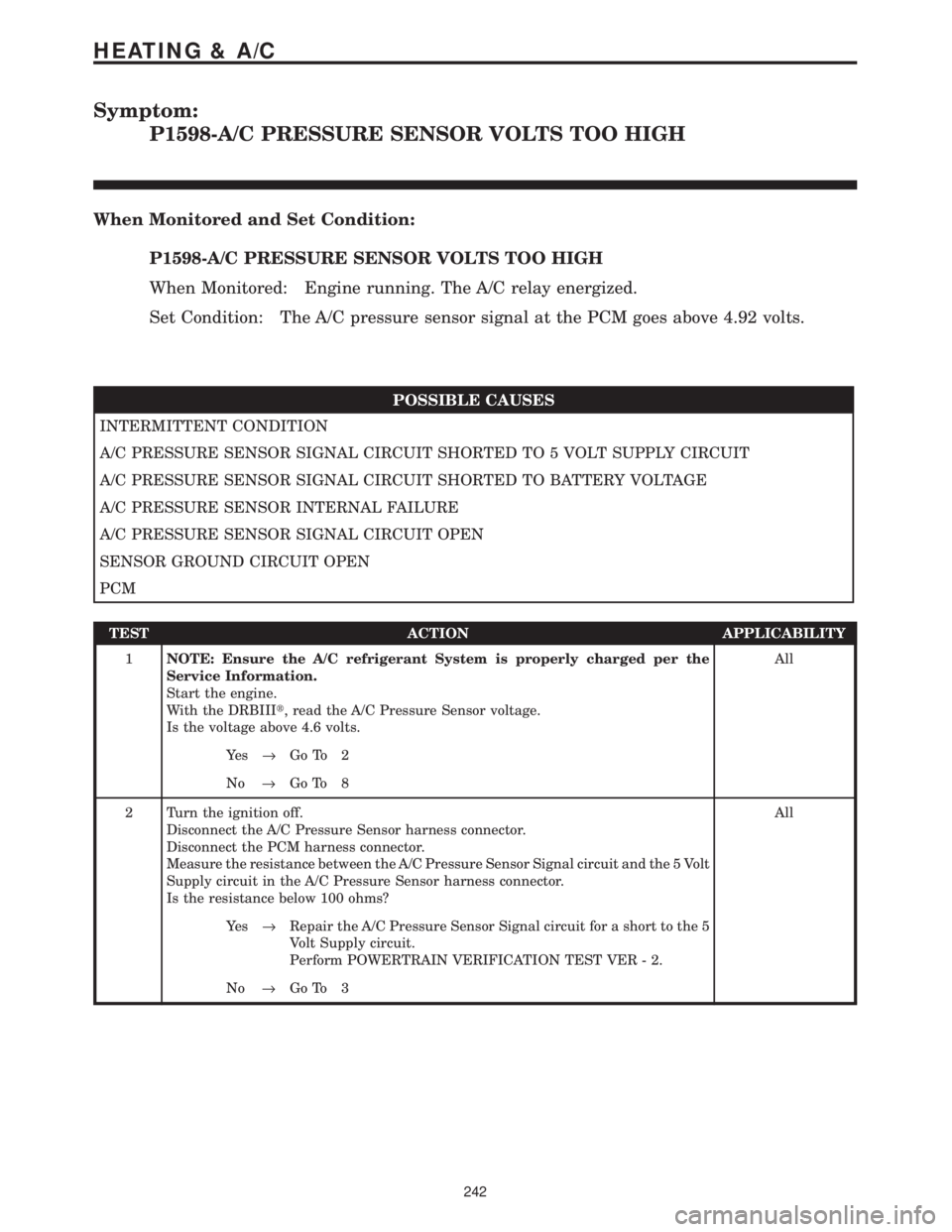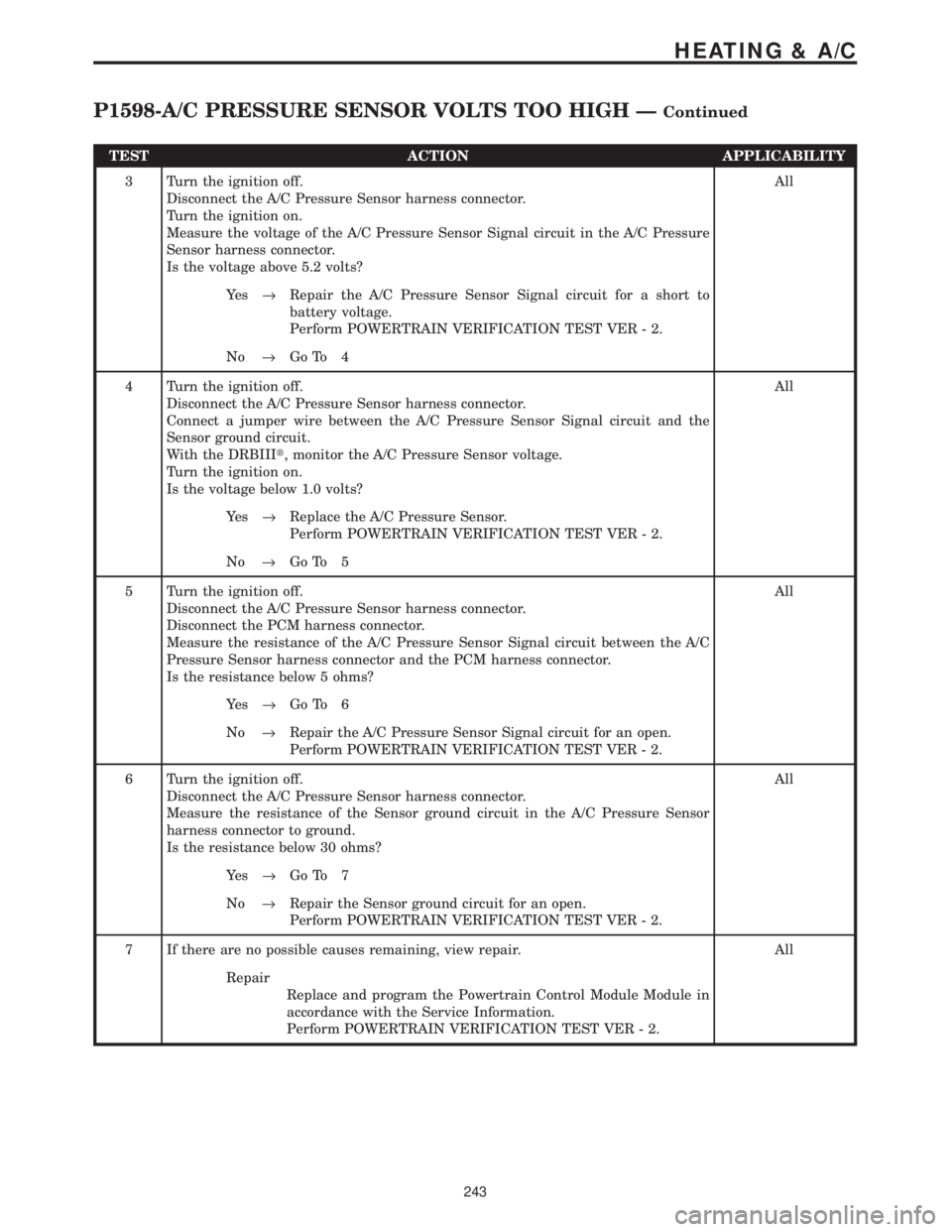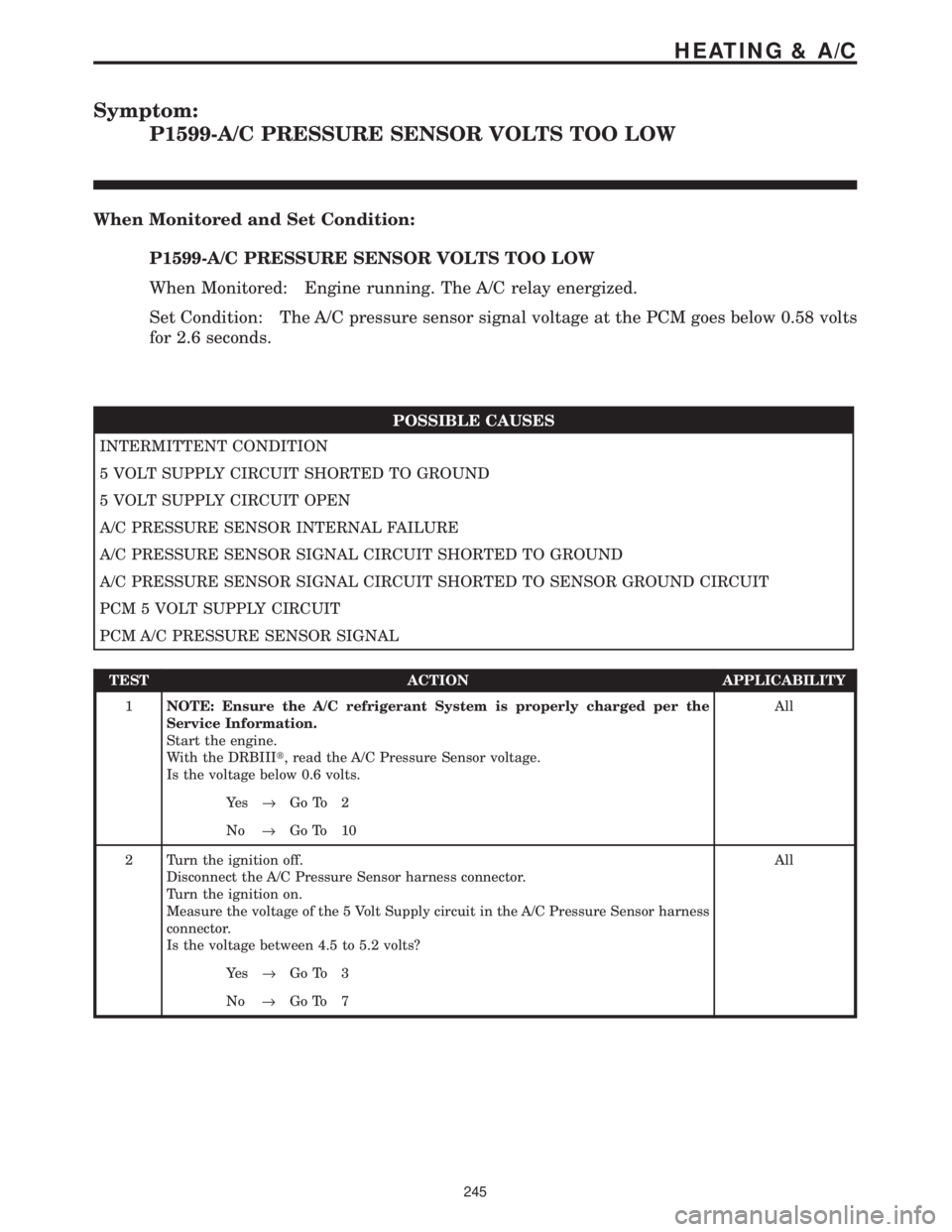Page 4020 of 4284
Symptom:
*CHECKING ECT SENSOR
POSSIBLE CAUSES
ECT SENSOR OPERATION
ECT SENSOR
TEST ACTION APPLICABILITY
1NOTE: The engine coolant temperature must be below 62ÉC (150ÉF).
Turn the ignition on.
With the DRBIIIt, monitor the ECT value.
Start the engine.
Does the ECT reach 82ÉC (180ÉF) and was it a smooth transition?All
Ye s®Engine Coolant Temperature sensor is operating normally.
Perform POWERTRAIN VERIFICATION TEST VER - 2.
No®Replace the Engine Coolant Temperature Sensor.
Perform POWERTRAIN VERIFICATION TEST VER - 2.
226
DRIVEABILITY - GAS
Page 4026 of 4284
Symptom:
*CHECKING IAT SENSOR
POSSIBLE CAUSES
IAT SENSOR OPERATION
IAT SENSOR
TEST ACTION APPLICABILITY
1NOTE: Do not allow more than 5 minutes delay during the removal of the
IAT sensor and measure the temperature.
Turn the ignition on.
With the DRBIIIt, read and record the IAT temperature value.
Remove the IAT sensor.
Using a temperature probe, measure the temperature inside the opening of the IAT
sensor.
Compare both temperature readings.
Are the temperature readings with 12ÉC (10ÉF) of one another?All
Ye s®The IAT sensor is operating normally.
Perform POWERTRAIN VERIFICATION TEST VER - 2.
No®Replace the IAT sensor.
Perform POWERTRAIN VERIFICATION TEST VER - 2.
232
DRIVEABILITY - GAS
Page 4027 of 4284
Symptom:
*CHECKING MAP SENSOR
POSSIBLE CAUSES
MAP SENSOR OPERATION
MAP SENSOR
TEST ACTION APPLICABILITY
1 Turn the ignition off.
Attach a vacuum gauge to a manifold vacuum source.
NOTE: If the engine will not idle, maintain a constant engine speed above
idle.
Allow the engine to idle.
With the DRBIIIt, monitor the MAP sensor vacuum.
Compare the MAP vacuum value on the DRBIIItand the vacuum reading on the
vacuum gauge.
Are the vacuum readings within 1 inch of vacuum of each other?All
Ye s®The MAP sensor is operating normally.
Perform POWERTRAIN VERIFICATION TEST VER - 2.
No®Replace the MAP sensor.
Perform POWERTRAIN VERIFICATION TEST VER - 2.
233
DRIVEABILITY - GAS
Page 4032 of 4284
Symptom:
*CHECKING TP SENSOR
POSSIBLE CAUSES
THROTTLE POSITION SENSOR VOLTAGE ABOVE 1.5 VOLTS
THROTTLE POSITION SENSOR SWEEP
TP SENSOR
TEST ACTION APPLICABILITY
1NOTE: Ensure that the throttle and linkage is not binding and is operating
properly.
Turn the ignition on.
With the DRBIIIt, read the Throttle Position Sensor voltage.
Is the voltage above 1.5 volts?All
Ye s®Replace the Throttle Position Sensor.
Perform POWERTRAIN VERIFICATION TEST VER - 2.
No®Go To 2
2 Turn the ignition on.
With the DRBIIIt, monitor the Throttle Position Sensor voltage.
Slowly open the throttle from the idle position to the wide open throttle position.
Does voltage start at approximately 0.8 volts and go above 3.5 volts with a smooth
voltage change?All
Ye s®Throttle Position Sensor Operating normally.
Perform POWERTRAIN VERIFICATION TEST VER - 2.
No®Replace the Throttle Position Sensor.
Perform POWERTRAIN VERIFICATION TEST VER - 2.
238
DRIVEABILITY - GAS
Page 4036 of 4284

Symptom:
P1598-A/C PRESSURE SENSOR VOLTS TOO HIGH
When Monitored and Set Condition:
P1598-A/C PRESSURE SENSOR VOLTS TOO HIGH
When Monitored: Engine running. The A/C relay energized.
Set Condition: The A/C pressure sensor signal at the PCM goes above 4.92 volts.
POSSIBLE CAUSES
INTERMITTENT CONDITION
A/C PRESSURE SENSOR SIGNAL CIRCUIT SHORTED TO 5 VOLT SUPPLY CIRCUIT
A/C PRESSURE SENSOR SIGNAL CIRCUIT SHORTED TO BATTERY VOLTAGE
A/C PRESSURE SENSOR INTERNAL FAILURE
A/C PRESSURE SENSOR SIGNAL CIRCUIT OPEN
SENSOR GROUND CIRCUIT OPEN
PCM
TEST ACTION APPLICABILITY
1NOTE: Ensure the A/C refrigerant System is properly charged per the
Service Information.
Start the engine.
With the DRBIIIt, read the A/C Pressure Sensor voltage.
Is the voltage above 4.6 volts.All
Ye s®Go To 2
No®Go To 8
2 Turn the ignition off.
Disconnect the A/C Pressure Sensor harness connector.
Disconnect the PCM harness connector.
Measure the resistance between the A/C Pressure Sensor Signal circuit and the 5 Volt
Supply circuit in the A/C Pressure Sensor harness connector.
Is the resistance below 100 ohms?All
Ye s®Repair the A/C Pressure Sensor Signal circuit for a short to the 5
Volt Supply circuit.
Perform POWERTRAIN VERIFICATION TEST VER - 2.
No®Go To 3
242
HEATING & A/C
Page 4037 of 4284

TEST ACTION APPLICABILITY
3 Turn the ignition off.
Disconnect the A/C Pressure Sensor harness connector.
Turn the ignition on.
Measure the voltage of the A/C Pressure Sensor Signal circuit in the A/C Pressure
Sensor harness connector.
Is the voltage above 5.2 volts?All
Ye s®Repair the A/C Pressure Sensor Signal circuit for a short to
battery voltage.
Perform POWERTRAIN VERIFICATION TEST VER - 2.
No®Go To 4
4 Turn the ignition off.
Disconnect the A/C Pressure Sensor harness connector.
Connect a jumper wire between the A/C Pressure Sensor Signal circuit and the
Sensor ground circuit.
With the DRBIIIt, monitor the A/C Pressure Sensor voltage.
Turn the ignition on.
Is the voltage below 1.0 volts?All
Ye s®Replace the A/C Pressure Sensor.
Perform POWERTRAIN VERIFICATION TEST VER - 2.
No®Go To 5
5 Turn the ignition off.
Disconnect the A/C Pressure Sensor harness connector.
Disconnect the PCM harness connector.
Measure the resistance of the A/C Pressure Sensor Signal circuit between the A/C
Pressure Sensor harness connector and the PCM harness connector.
Is the resistance below 5 ohms?All
Ye s®Go To 6
No®Repair the A/C Pressure Sensor Signal circuit for an open.
Perform POWERTRAIN VERIFICATION TEST VER - 2.
6 Turn the ignition off.
Disconnect the A/C Pressure Sensor harness connector.
Measure the resistance of the Sensor ground circuit in the A/C Pressure Sensor
harness connector to ground.
Is the resistance below 30 ohms?All
Ye s®Go To 7
No®Repair the Sensor ground circuit for an open.
Perform POWERTRAIN VERIFICATION TEST VER - 2.
7 If there are no possible causes remaining, view repair. All
Repair
Replace and program the Powertrain Control Module Module in
accordance with the Service Information.
Perform POWERTRAIN VERIFICATION TEST VER - 2.
243
HEATING & A/C
P1598-A/C PRESSURE SENSOR VOLTS TOO HIGH ÐContinued
Page 4038 of 4284

TEST ACTION APPLICABILITY
8NOTE: Ensure the A/C refrigerant System is properly charged per the
Service Information.
NOTE: The conditions that set the DTC are not present at this time. The
following list may help in identifying the intermittent condition.
WARNING: WHEN THE ENGINE IS OPERATING, DO NOT STAND IN A
DIRECT LINE WITH THE FAN. DO NOT PUT YOUR HANDS NEAR THE
PULLEYS, BELTS OR FAN. DO NOT WEAR LOOSE CLOTHING.
With the engine running at normal operating temperature, monitor the DRB
parameters related to the DTC while wiggling the wiring harness. Look for param-
eter values to change and/or a DTC to set.
Review the DRB Freeze Frame information. If possible, try to duplicate the
conditions under which the DTC was set.
Refer to any Technical Service Bulletins (TSB) that may apply.
Visually inspect the related wiring harness. Look for any chafed, pierced, pinched, or
partially broken wires.
Visually inspect the related wiring harness connectors. Look for broken, bent, pushed
out, or corroded terminals.
Were any of the above conditions present?All
Ye s®Repair as necessary
Perform POWERTRAIN VERIFICATION TEST VER - 2.
No®Test Complete.
244
HEATING & A/C
P1598-A/C PRESSURE SENSOR VOLTS TOO HIGH ÐContinued
Page 4039 of 4284

Symptom:
P1599-A/C PRESSURE SENSOR VOLTS TOO LOW
When Monitored and Set Condition:
P1599-A/C PRESSURE SENSOR VOLTS TOO LOW
When Monitored: Engine running. The A/C relay energized.
Set Condition: The A/C pressure sensor signal voltage at the PCM goes below 0.58 volts
for 2.6 seconds.
POSSIBLE CAUSES
INTERMITTENT CONDITION
5 VOLT SUPPLY CIRCUIT SHORTED TO GROUND
5 VOLT SUPPLY CIRCUIT OPEN
A/C PRESSURE SENSOR INTERNAL FAILURE
A/C PRESSURE SENSOR SIGNAL CIRCUIT SHORTED TO GROUND
A/C PRESSURE SENSOR SIGNAL CIRCUIT SHORTED TO SENSOR GROUND CIRCUIT
PCM 5 VOLT SUPPLY CIRCUIT
PCM A/C PRESSURE SENSOR SIGNAL
TEST ACTION APPLICABILITY
1NOTE: Ensure the A/C refrigerant System is properly charged per the
Service Information.
Start the engine.
With the DRBIIIt, read the A/C Pressure Sensor voltage.
Is the voltage below 0.6 volts.All
Ye s®Go To 2
No®Go To 10
2 Turn the ignition off.
Disconnect the A/C Pressure Sensor harness connector.
Turn the ignition on.
Measure the voltage of the 5 Volt Supply circuit in the A/C Pressure Sensor harness
connector.
Is the voltage between 4.5 to 5.2 volts?All
Ye s®Go To 3
No®Go To 7
245
HEATING & A/C